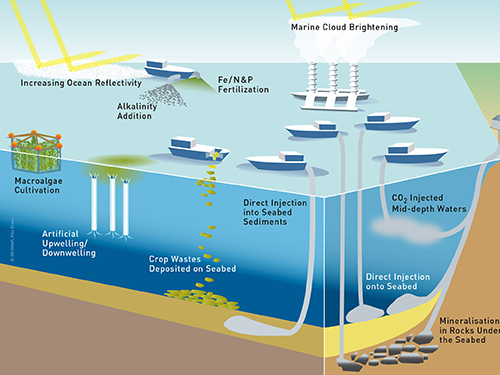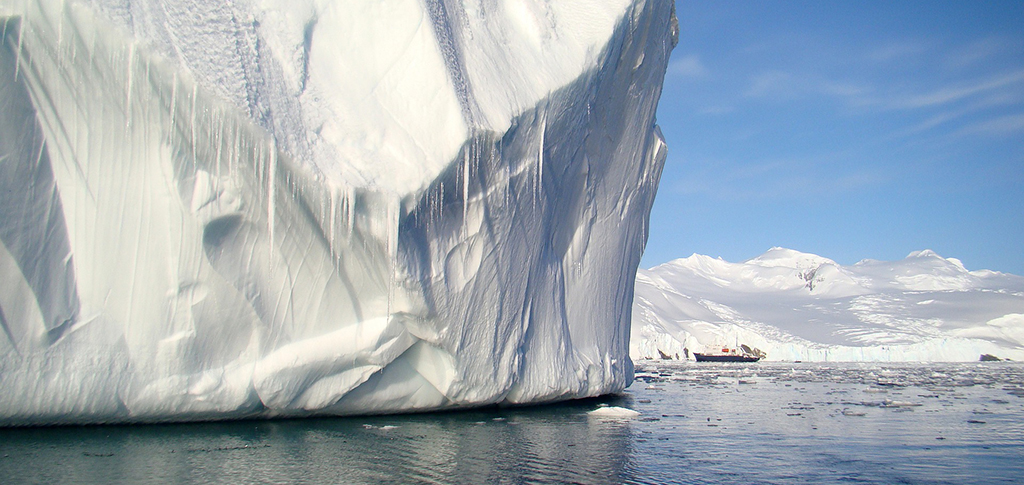Marine geoengineering techniques for climate change mitigation - LP/LC evaluates potential for marine environment effects.

Parties to the treaties which regulate the dumping of wastes at sea have adopted a statement identifying the need to carefully evaluate marine geoengineering techniques, which may have potential for mitigating the effects of climate change but may have adverse impacts on the marine environment.
Parties to the treaties which regulate the dumping of wastes at sea have adopted a statement identifying the need to carefully evaluate marine geoengineering techniques, which may have potential for mitigating the effects of climate change but may have adverse impacts on the marine environment.
The statement identifies four techniques which need priority evaluation, involving either carbon dioxide removal (CDR) or solar radiation modification (SRM).
The statement was adopted by the 44th Consultative Meeting of Contracting Parties to the London Convention and the 17th Meeting of Contracting Parties to the London Protocol (LC 44/LP 17), which met at the International Maritime Organization (IMO) Headquarters from 3-7 October 2022.
The statement notes that marine geoengineering should not be considered as a substitute for measures to reduce carbon dioxide emissions, there are investigations into the potential for marine geoengineering to mitigate the effects of climate change with multiple interests driving urgency for deployment.
The statement recognizes the growing interest into marine geoengineering techniques and their potential to cause pollution or other adverse effects on the marine environment.
The London Protocol /London Convention parties identify four techniques for priority evaluation:
enhancing ocean alkalinity (CDR);
macroalgae cultivation and other biomass for sequestration including artificial upwelling (CDR);
marine cloud brightening (SRM); and
microbubbles/reflective particles/material (SRM).
In 2008 Parties to the LP and LC adopted a resolution (LC-LP.1 (2008)), which states that ocean fertilization activities fall within the purview of the LC/LP and that ocean fertilization activities other than legitimate scientific research should not be allowed.
A further resolution (LC-LP.2 (2010)) on the "Assessment Framework for Scientific Research involving Ocean Fertilization," that proposed research projects should be assessed to determine if they qualify as legitimate scientific research.
Together, these resolutions apply to all LC Contracting Parties and continue to apply to LP Contracting Parties, pending the entry into force of the 2013 amendment to the London Protocol. The 2013 amendment will, when in force create a legally binding regime providing a science based, global, transparent and effective regulatory and control mechanism for marine geoengineering. The amendment enables the future regulation of marine geoengineering techniques that fall within the scope of the London Protocol and have the potential to cause widespread, long-lasting or severe impacts on the marine environment.
A 2019 report published by the Joint Group of Experts on the Scientific Aspects of Marine Environmental Protection (GESAMP) provides an overview of a wide range of marine geoengineering techniques. Read more here.
Read more on the LC/LP and Climate Change.
London Protocol /London Convention
The objective of the London Protocol and Convention is to promote the effective control of all sources of marine pollution. Contracting Parties shall take effective measures to prevent pollution of the marine environment caused by dumping at sea. (Read more here).
STATEMENT ON MARINE GEOENGINEERING
MINDFUL of the Intergovernmental Panel on Climate Change (IPCC) report of 2018 (special report of 1.5 degree)* and the IPCC Sixth Assessment Report;**
RECALLING the 2008 and 2010 resolutions on ocean fertilization, and the 2013 resolution adopting the amendment to the London Protocol to regulate marine geoengineering;
URGING the ratification and implementation of the 2013 amendment, while recognizing the controls provided in the 2008 and 2010 resolutions;
EMPHASIZING that marine geoengineering should not be considered as a substitute for measures to reduce carbon dioxide emissions;
MINDFUL of investigations into the potential for marine geoengineering to mitigate the effects of climate change and of multiple interests driving urgency for deployment;
ACKNOWLEDGING the limited information about certain marine geoengineering techniques and scientific uncertainties on effectiveness; and
ACKNOWLEDGING nonetheless the potential for these techniques to have deleterious effects, especially where those effects may be widespread, long lasting or severe.
The forty-fourth Consultative Meeting of Contracting Parties to the Convention on the Prevention of Marine Pollution by Dumping of Wastes and Other Matter, 1972 (London Convention), convened in conjunction with the seventeenth Meeting of Contracting Parties to the 1996 Protocol to the London Convention, 1972 (London Protocol), developed the following "statement on marine geoengineering".
The governing bodies recognize the growing interest into marine geoengineering*** techniques and their potential to cause pollution**** or other adverse effects on the marine environment.
Based on the information in the GESAMP WG 41 report of 2019,***** the advice provided by GESAMP to the Scientific Groups (LC/SG 45/3) and the further refinement and prioritization of the techniques outlined in the report of the Correspondence Group on Marine Geoengineering (LC 44/5), the governing bodies have identified four techniques for priority evaluation.
These four techniques involve either carbon dioxide removal (CDR) or solar radiation modification (SRM), as follows:
enhancing ocean alkalinity (CDR);
macroalgae cultivation and other biomass for sequestration including artificial upwelling (CDR);
marine cloud brightening (SRM); and
microbubbles/reflective particles/material (SRM).
The LP and LC Parties are undertaking a legal and technical analysis in order to evaluate options for appropriate action, including regulation, within the scope of LP/LC.
Furthermore, taking into account the precautionary approach outlined in Article 3 of the London Protocol (LP), and while the 2013 LP amendment on marine geoengineering awaits entry into force (resolution LP.4(8)), the governing bodies encourage Contracting Parties to apply annex 5 (the marine geoengineering assessment framework) to evaluate proposed marine geoengineering projects, including the four techniques mentioned above, to apply the utmost caution to their consideration, and to provide information to LP/LC about ongoing and planned marine geoengineering activities.
Background information on LP/LC ocean fertilization resolutions and the 2013 LP amendment In 2008, Parties to LP and LC adopted resolution LC-LP.1 (2008) by consensus. The resolution states that ocean fertilization activities fall within the purview of LC/LP and that ocean fertilization activities other than legitimate scientific research should not be allowed. LP and LC Parties also agreed under resolution LC-LP.2 (2010) on the "Assessment Framework for Scientific Research involving Ocean Fertilization" that proposed research projects should be assessed to determine if they qualify as legitimate scientific research. Together, these resolutions apply to all LC Contracting Parties and continue to apply to LP Contracting Parties, pending the entry into force of the 2013 amendment to LP. In 2013, LP was amended to further regulate ocean fertilization. This amendment will, when in force, create a legally binding regime providing a science based, global, transparent and effective regulatory and control mechanism for marine geoengineering. The amendment enables the future regulation of marine geoengineering techniques that fall within the scope of LP and have the potential to cause widespread, long-lasting or severe impacts on the marine environment. |
44th Consultative Meeting of Contracting Parties to the London Convention and the 17th Meeting of Contracting Parties to the London Protocol (LC 44/LP 17)
Dumping of sewage sludge to be prohibited
The LC/LP meeting adopted an amendment to ensure that the dumping of sewage sludge at sea would be prohibited worldwide. Read more here.
50 years of the London Convention
In 2022, IMO is marking 50 years since the adoption of the London Convention. The adoption of the Convention was a major achievement, which, along with the 1972 United Nations Conference on the Environment in Stockholm, constituted the first steps to truly put the environment at centre stage and take responsibility for the harm humans have done to the ocean.
Download infographic illustrating the main steps taken under the London Convention since 1972.
The purpose of the London Convention is to control all sources of marine pollution and prevent pollution of the sea through regulation of dumping into the sea of waste materials. A so-called "black- and grey-list" approach is applied for wastes, which can be considered for disposal at sea according to the hazard they present to the environment. For the blacklist items dumping is prohibited. Dumping of the grey-listed materials requires a special permit from a designated national authority under strict control and provided certain conditions are met. All other materials or substances can be dumped after a general permit has been issued.
The purpose of the Protocol is similar to that of the Convention, but the Protocol is more restrictive: application of a "precautionary approach" is included as a general obligation and a "reverse list" approach is adopted, which implies that all dumping is prohibited unless explicitly permitted.
The London Protocol entered into force on 24 March 2006. The London Protocol has 53 Parties to the Protocol. (Read more here).
Conference - Protecting the Ocean - Moving forward at 50: London Convention & Stockholm Declaration
IMO and the World Maritime University (WMU) are holding a joint academic conference (10-13 October) to discuss ocean and climate related topics under the framework of the London Convention and Stockholm Declaration's 50th anniversaries. Read more here.
-----
* IPCC, 2018: Summary for Policymakers. In: Global Warming of 1.5°C. An IPCC Special Report on the impacts of global warming of 1.5°C above pre-industrial levels and related global greenhouse gas emission pathways, in the context of strengthening the global response to the threat of climate change, sustainable development and efforts to eradicate poverty. Cambridge University Press, Cambridge, UK and New York, NY, USA, pp. 3-24. https://doi.org/10.1017/9781009157940.001
** IPCC, 2022: Climate Change 2022: Mitigation of Climate Change. Contribution of Working Group III to the Sixth Assessment Report of the Intergovernmental Panel on Climate Change. Cambridge University Press, Cambridge, UK and New York, NY, USA. doi: 10.1017/9781009157926.
*** As defined in resolution LP.4(8), "Marine geoengineering" means a deliberate intervention in the marine environment to manipulate natural processes, including to counteract anthropogenic climate change and/or its impacts, and that has the potential to result in deleterious effects, especially where those effects may be widespread, long lasting or severe.
**** As defined in Article 1.10 of the London Protocol, Pollution means the introduction, directly or indirectly, by human activity, of wastes or other matter into the sea which results or is likely to result in such deleterious effects as harm to living resources and marine ecosystems, hazards to human health, hindrance to marine activities, including fishing and other legitimate uses of the sea, impairment of quality for use of seawater and reduction of amenities.
***** GESAMP (2019). "High level review of a wide range of proposed marine geoengineering techniques". (Boyd, P.W. and Vivian, C.M.G., eds.). (IMO/FAO/UNESCO-IOC/UNIDO/WMO/IAEA/UN/UN Environment/UNDP/ISA Joint Group of Experts on the Scientific Aspects of Marine Environmental Protection). Rep. Stud. GESAMP No. 98, 144 p.
